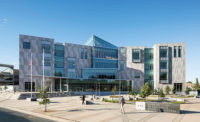

The museum is being constructed on the edge of Doha Harbour, and it will showcase some of the world's finest Islamic Art. With nearly 500,000 square feet of space, the new building will contain six floors of multiple exhibition galleries in addition to a library, galleries, gardens and a restaurant. Additionally, an educational wing will accommodate a School for Islamic Arts Education.
The exterior of the building will include over 3,500 cubic meters of Jet Mist granite from Virginia. Material for the project is being extracted at quarry sites owned by R.E.D. Graniti of Italy as well as New England Stone, LLC, of Kingston, RI. Because the stone has a tight color range - as well as uniformity in its patterning - it was the ideal stone for a project of this size and scope.
Material is being fabricated by Campolonghi Group of Massa, Italy, which has completed work for large-scale architectural projects around the world. CNC machinery from Omag is being used for some of the most complex fabrication work, including the Omag Mill 5 and the Omag Mill 98. The massive Omag Mill 5 runs on five axes, and it was engineered for deep milling and shaping of large elaborate dimensional stone and architectural items.
In addition to the CNC machinery, a range of other equipment is being used at Campolonghi to process Jet Mist granite for the project, including bridge saws from GMM and Pedrini.
The project was designed by renowned American architect I.M. Pei, who recently explained his philosophies to Architectural Record: “Qatar does not have much history, it's a new emirate. So I couldn't draw on the history of the country; its history is really just being a desert. But I thought, the one thing I must learn about for this project is the Islamic faith. So I read about Islam and Islamic architecture, and the more I studied the more I realized where the best Islamic buildings were. At the beginning, I thought the best Islamic work was in Spain - the mosque in Cordoba, the Alhambra in Granada. But as I learned more, my ideas shifted. To begin with, the climate of southern Spain is not at all like desert, where most Islamic architecture is built. I kept searching. I traveled to Egypt, and to the Middle East many times. I saw early Islamic architecture in Damascus, Syria, where they took some early Christian churches and transformed them into mosques, so they were not pure Islamic-just as in southern Spain, it's no longer pure Islamic architecture either, because it gets mingled with Christianity. Or in Turkey, where the Ottoman influence is felt, too - it's Islamic but not pure Islamic.â€
I.M. Pei also told Architectural Record his research relied on Egyptian influences. “I found the most wonderful examples of Islamic work in Cairo, it turns out. I'd visited mosques there before, but I didn't see them with the same eye as I did this time. They truly said something to me about Islamic architecture. The museum I'm designing is more influenced by the Mosque of Ibn Tulun than any other building. This mosque is very austere and beautiful, its geometry is most refined. You think of Gothic architecture, it's so elaborate. This is the opposite - so simple.â€
The fabrication and supply of granite for the Museum of Islamic Arts is ongoing, and the project is expected to be completed next year.





